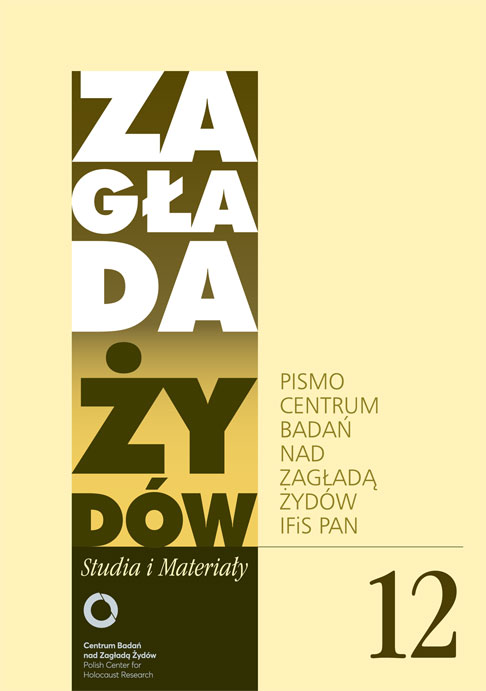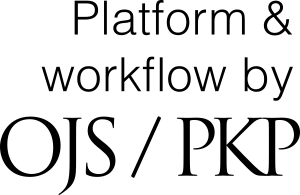Zagłada jako horror. Kilka uwag o literaturze polskiej 1985–2015
Zagłada Żydów. Studia i Materiały, Nr 12 (2016), Strony: 375-394
Data zgłoszenia: 2020-10-20Data publikacji: 2016-11-30
 https://doi.org/10.32927/ZZSiM.423
https://doi.org/10.32927/ZZSiM.423
Abstrakt
The author suggests that the depictions of the Holocaust in Polish literature of 1918–2014 should be categorized as horror. From the chronological perspective, Czapliński divides those thirty years into three shorter periods: 1) the initial period (from Claude Lanzmann’s Shoah and Jan Błoński’s essay “The Poor Poles Look at the Ghetto” to Wilhelm Dichter’s and Michał Głowiński’s memoirs) was dominated by white horror, which presented Jews as ghosts demanding a place in the Polish memory; 2) during the second period (from Marek Bieńczyk’s Tworki and Jan Tomasz Gross’ Neighbors until the end of the 2010s) the horror poetics was used to reveal those principles of pre-war and occupation-period normality which helped the Germans conduct the Holocaust and which conditioned the exclusion of Jews from the Polish circle of ‘normal humanity’; 3) during the third period (from Gross’s Golden Harvest until now) Jews return as the undead, violating the rules of distance and obliging Poles to physically touch the disgusting topic of the Holocaust. The contact with the Holocaust as something abhorring becomes a condition for self-knowledge, purging, and establishment of a new imaginary community.
Słowa kluczowe
Zagłada , horror , groza , obrzydliwość
Licencja
Prawa autorskie (c) 2016 Autor&"Zagłada Żydów. Studia i Materiały"

Utwór dostępny jest na licencji Creative Commons Uznanie autorstwa 4.0 Międzynarodowe.
https://creativecommons.org/licenses/by/4.0
Czasopismo publikowane jest w standardzie Diamond Open Access na licencji CC-BY-4.0 Deed - Uznanie autorstwa 4.0 Międzynarodowa - Creative Commons
Inne teksty tego samego autora
- Przemysław Czapliński, The Auschwitz Virus , Zagłada Żydów. Studia i Materiały: Nr Holocaust Studies and Materials (2017)
- Przemysław Czapliński, Prawda i co dalej , Zagłada Żydów. Studia i Materiały: Nr 15 (2019)
- Przemysław Czapliński, Wirus Auschwitz , Zagłada Żydów. Studia i Materiały: Nr 10 (2014)
Podobne artykuły
- Dariusz Libionka, Jacek Leociak, 75. rocznica akcji „Reinhardt” , Zagłada Żydów. Studia i Materiały: Nr 13 (2017)
- Małgorzata Melchior, Zagłada i stosunki polsko – żydowskie w opracowaniach socjologicznych. , Zagłada Żydów. Studia i Materiały: Nr 1 (2005)
- Jacek Leociak, Adam Mazur, Artur Żmijewski, „Berek jest głosem o niemocy wobec okrucieństwa; pragnieniem, by Zagłada się nie wydarzyła”. Z Arturem Żmijewskim rozmawiają Jacek Leociak i Adam Mazur , Zagłada Żydów. Studia i Materiały: Nr 17 (2021)
- Dariusz Libionka, Barbara Engelking, Od Redakcji , Zagłada Żydów. Studia i Materiały: Nr 20 (2024)
- Alina Skibinska, „Ludzie opowiadali rzeczy potworne o tym, co się tam działo”. Dwa świadectwa Zagłady – Adama Ulricha z Zakrzówka i Stanisława Ż(Rz)emińskiego z Łukowa , Zagłada Żydów. Studia i Materiały: Nr 13 (2017)
- Jacek Leociak, Ginczanka , Zagłada Żydów. Studia i Materiały: Nr 11 (2015)
- Agnieszka Kajczyk, Iwona Kurz, „Obraz typowy”. Album Zagłada Żydostwa Polskiego (1945) , Zagłada Żydów. Studia i Materiały: Nr 20 (2024)
- Alina Skibińska, Jakub Petelewicz, Udział Polaków w zbrodniach na Żydach na prowincji regionu Świętokrzyskiego , Zagłada Żydów. Studia i Materiały: Nr 1 (2005)
- Jacek Leociak, Marta Tomczok, Afektywny kicz holokaustowy – wprowadzenie , Zagłada Żydów. Studia i Materiały: Nr 17 (2021)
- Dariusz Libionka, Jan Grabowski, Anatomia donosu ks. Stanisława Trzeciaka na ks. Tadeusza Pudra , Zagłada Żydów. Studia i Materiały: Nr 13 (2017)
1 2 3 4 5 6 7 8 9 10 11 12 13 14 15 16 17 18 19 20 21 22 23 24 25 26 27 28 29 30 31 32 33 34 35 36 37 38 39 40 41 42 43 44 > >>
Możesz również Rozpocznij zaawansowane wyszukiwanie podobieństw dla tego artykułu.
 English
English
 Język Polski
Język Polski



 https://orcid.org/0000-0002-4805-6471
https://orcid.org/0000-0002-4805-6471

